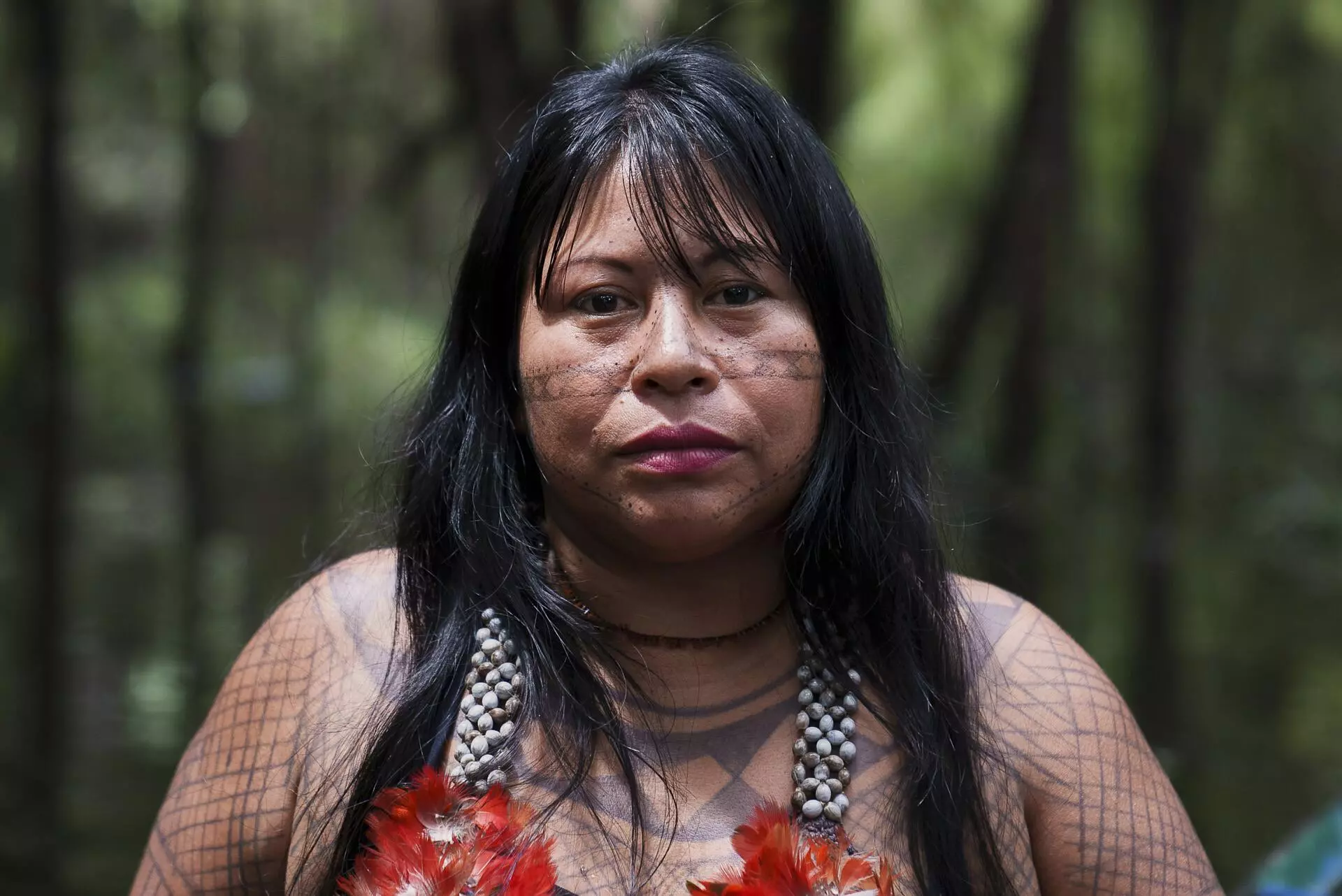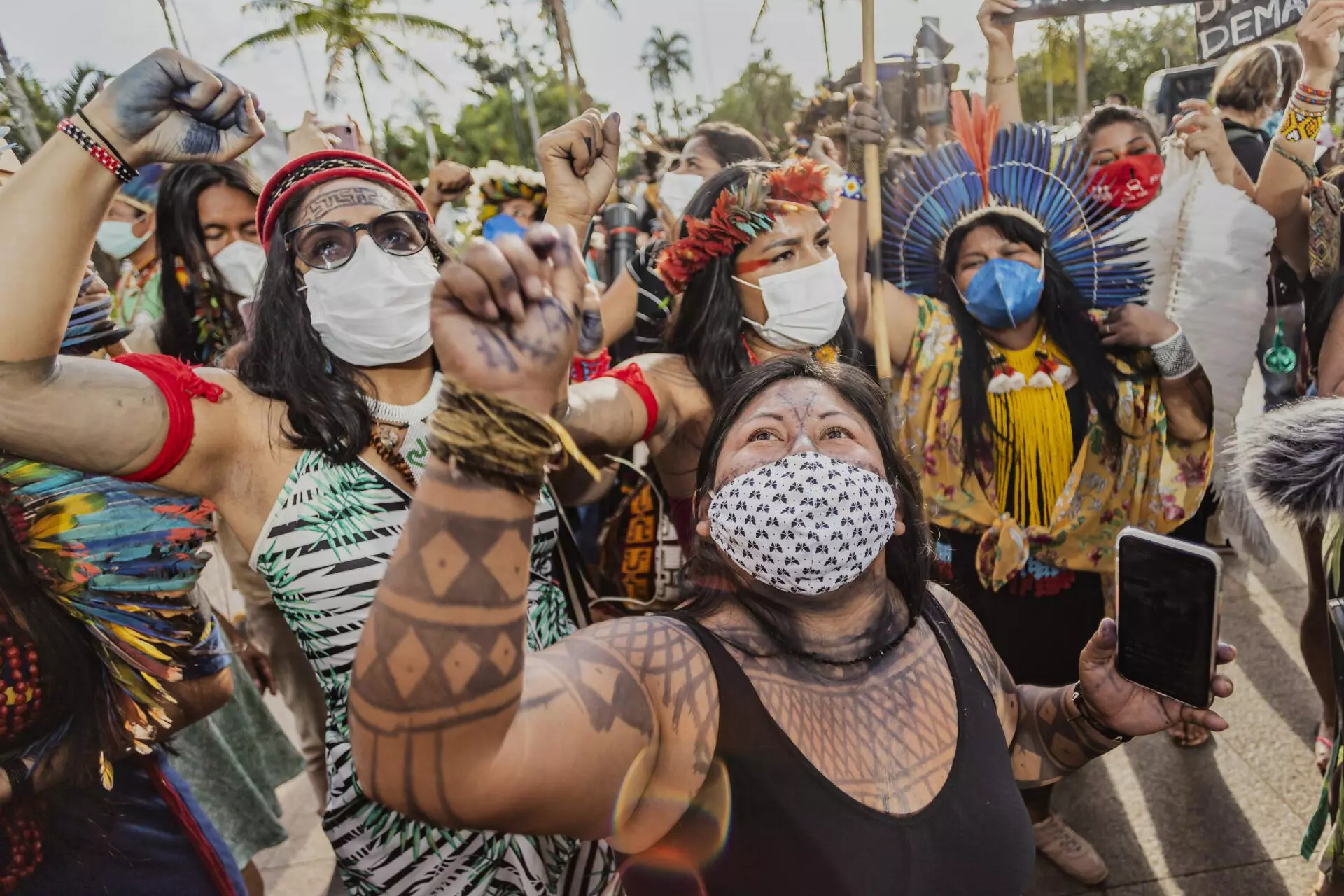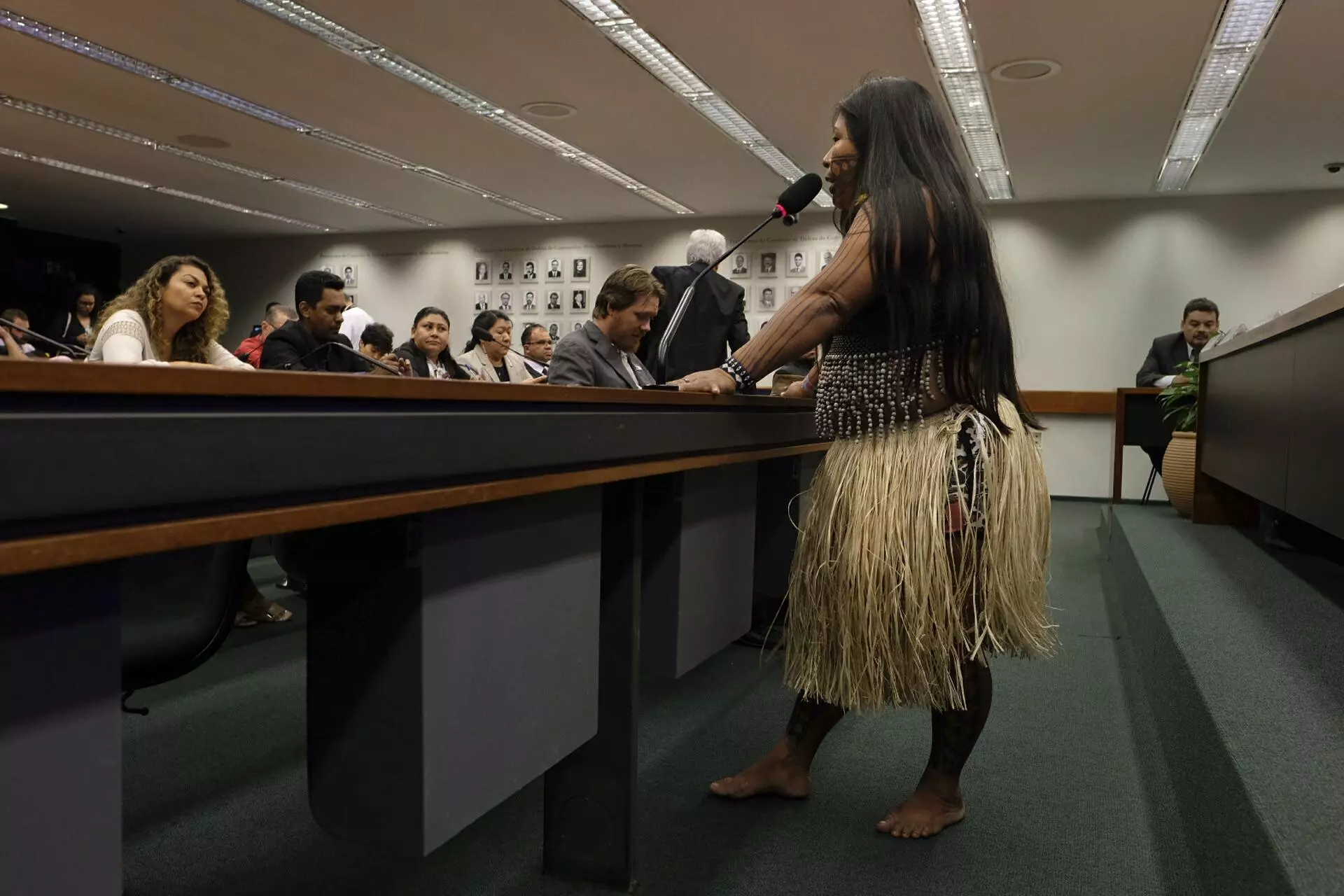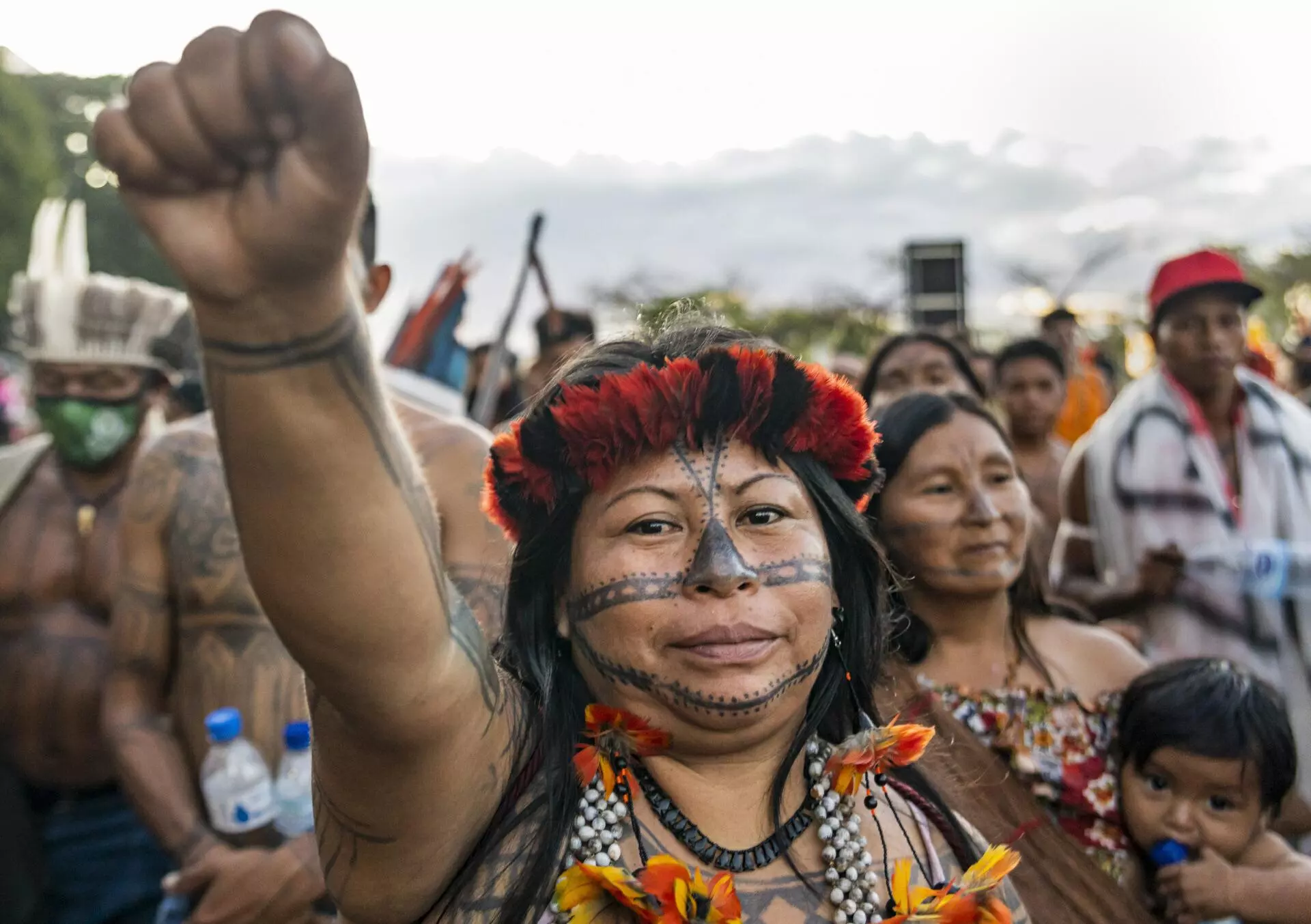Alessandra Korap Munduruku was born and raised on the banks of the Tapajós River, in a village near Itaituba in the southwest of the Brazilian state of Pará. As an Indigenous child, and the eldest of seven siblings, she spent her childhood swimming in the river and running in the woods, making play-tapirs and pretend-hunting the real thing, pretend-fishing, and pretend-gathering maniocs. But then she watched the city grow, and grow…until it swallowed up her village.
Today, Praia do Índio (which means “Indian Beach”) is an Indigenous reserve in a neighborhood of Itaituba, a city in the Amazon dominated by illegal mining. Alessandra, meanwhile, has grown into an Indigenous leader who has received death threats for her fight for a standing forest, for mercury-free rivers, and for bodies that are not poisoned by blood. This Monday, the Munduruku woman will take the stage in San Francisco, California, to receive the prestigious Goldman Prize for Environmentalism, which each year recognizes the efforts of six activists, one from each continent on the planet. A second ceremony will take place in Washington, later this month, in the presence of former US Congressional speaker Nancy Pelosi.
Alessandra learnt to fight during the battle to stop mega-dams on the Tapajós River, under the government of Dilma Rousseff (Brazil’s president between 2011 and 2016). She saw the threat posed by soy trucks and huge grain barges, leading to the construction of the port of Miritituba, one of the main export routes for agribusiness in the state of Mato Grosso. She witnessed the explosion of mining under the government of far right extremist Jair Bolsonaro, stirring up internal ethnic conflicts and contaminating the waters that flow through the Munduruku territory.
Faced with such threats to her land, inspired by the passionate political activities of Indigenous chiefs and scarred by the pain of the racism she had suffered since childhood, she became one of the most important and well-known leaders of her people. “I had a lot of freedom when I was a young child, I walked everywhere, along the river, in the forest. When we are young, we don’t think much, do we? We want to live. But when I had kids, I started thinking about them. I saw that when I walked through the (Indigenous) territory there was no longer so much space. We went to get açai, or bacaba (a type of fruit) … and there wasn’t any. It was hard to catch fish. There were lots of barges on the river, scaring the fish away. We were retreating within our territory,” she tells SUMAÚMA. “I went to an assembly, in 2014, and listened to the chiefs talk. I realized our territory was being threatened. And I thought about how my children will get married one day, and have children, and their children will have children. And where will they go?”

Once she had children, Alessandra Korap Munduruku says, she began to think about their futures in an Indigenous Territory that was under threat: “Where will they go?” Photo: Goldman Environmental Prize
For Alê, as she is called by relatives and friends, her initiation into political life took place at a meeting of the Indigenous Missionary Council in 2014. At the center of the debate was the threat of PEC 215, a proposed constitutional amendment from Brazil’s agricultural sector to transfer the task of demarcating Indigenous lands to Congress (it has since been shelved). She remembers the activists from the Council warning about this and other threats, and found herself thinking: “It’s happening here too. We can’t gather seeds anymore because the land has been turned into lots, we can’t fish because of the barges, and where there used to be rocks where we could bathe, today the riverbanks are all mud. Our rights are being violated too.”
The debate opened up another world for Alessandra. “A world not just of playing, of being there, but another world, of fighting and resisting,” she says. Fighting and resisting are words often used when talking about the Munduruku people, who are historically known as great warriors and who dominated the entire Tapajós River valley, in the west of what is now the state of Pará. At the time of first contact with whites, they were so omnipresent the region was known as Mundurukânia (or “Munduruku-land”).
Today the Munduruku number around 14,000, and live in the Munduruku, Sai Cinza and Kayabi Indigenous territories, on the upper course of the Tapajós River and on the Teles Pires river; in the Sawré Muybu and Sawré Bap’in territories and in the Praia do Índio and Praia do Mangue reserves, in the middle course of the river basin. There are also Munduruku groups fighting to have their territories recognized in the Lower Tapajós region, near Santarém, and on the Madeira River, in the state of Amazonas. In the last decade, the Munduruku people have called for a process of self-demarcation, to define the limits of the Sawré Muybu land, located where the Dilma Rousseff government tried and failed to build the São Luiz do Tapajós hydroelectric plant.
The struggle for demarcation, in the refined political strategy of the Munduruku, was also an essential part of saving the river from destruction caused by the dam. The Indigenous people even occupied the construction sites of the Belo Monte power plant, paralyzing work in May 2013, to draw attention to what could happen to the Tapajós and the need to demarcate the Sawré Muybu territory. They only left the area after the Brazilian government agreed to meet with them in Brasília. At the time, Funai, Brazil’s federal agency for Indigenous affairs, admitted pressure from the electricity sector had caused progress in the demarcation process to stall. The Brazilian Constitution prohibits the removal of Indigenous communities, and the São Luiz do Tapajós dam would have flooded three Munduruku villages. In 2016, Funai officially ruled the plans for the dam were unconstitutional.
While the battle against the hydroelectric dams and the fight for self-demarcation raged, Alessandra Korap was taking her first steps in leadership. Alongside Maria Leusa Kaba, another prominent female leader of the Munduruku, who encouraged her to join the struggle, she began to speak at meetings. The Munduruku regularly hold large assemblies at which all those present – the elderly, children and adults – have a right to speak, and which are a fundamental part of the group’s mobilization and political decision-making processes. As part of this process, leaders from every village in a given region meet in a chosen village and spend days discussing extensive agendas on everything affecting their lives. Some non-Indigenous people are invited to participate, but the Munduruku language predominates.
It was not always this way. Alessandra recalls how one of the first campaigns she witnessed was that of Amâncio Ikõ Munduruku, who fought for the creation of schools with teachers who could teach in the Munduruku language. Amâncio, died of Covid-19 in 2020. At the time, non-Indigenous teachers, especially in the Middle Tapajós region, where Alê grew up, repressed the use of the mother tongue, and prohibited children from attending classes wearing genipap body paint. A generation was growing up ashamed of its own traditions, and for the Munduruku people education is a very important value. Amâncio won the fight, and schools were set up in the villages of the Itaituba region to ensure the teaching of the Munduruku language. But the experience of this racism left deep marks on Alessandra.

Indigenous women, such as Juma Xipaya and Sonia Guajajara, with Alessandra Korap Munduruku at the front, at the Stand Up For the Earth demonstration: fighting for the right to life and territory of Indigenous peoples, in June 2021. Photo Oliver Kornblihtt / Mídia NINJA
This strongly spoken, assertive Indigenous woman acquired fame on a national level during the 2019 Indigenous April demonstrations, when a video of a Munduruku meeting with the then President of the Brazilian Congress, Rodrigo Maia, went viral. In it, Alessandra beats on the table in front of an astonished Maia.
“Why aren’t our lands demarcated? Funai doesn’t exist anymore. That woman Damares (Alves, Minister of Women, Families and Human Rights under Jair Bolsonaro) doesn’t represent us Indigenous people. She doesn’t know what Indigenous is, she doesn’t know the Indigenous land, she doesn’t know the rivers, she doesn’t know what life is. And we have to tell Bolsonaro: respect our territory, respect our rights, respect our ancestors. We have been resisting for 519 years. And even if you take away our roots, they have already taken hold and are growing. They will bear more fruit and the flowers will spread, because we’re here to fight,” this warrior of the Munduruku told Maia.
Alessandra partly attributes her direct way of speaking to the trauma of racism that she has experienced since she was very young. “My words are always like that, very strong. I’ve always been like this, talking and shouting. If I think something is bad I’ll say so. I think it comes from this experience of violence. It made me not want to shut up, you know? I can’t remain silent when faced with things that are wrong.”
The Goldman Prize is an important acknowledgment of Alessandra’s and the Munduruku’s fight against illegal mining which has contaminated almost all of their parentes (the Portuguese word for familial relation, used by Indigenous people to refer to one another) in the Middle Tapajós region. At the request of the Munduruku, Brazil’s Oswaldo Cruz Foundation research institute undertook a study and, in 2022 reported that all 200 residents of Sawré Muybu were affected by mercury. Today, the Munduruku are demanding the Lula government establish a plan to eradicate mining and mercury.

Activist Alessandra Korap Munduruku requests the floor at a public hearing in the Brazilian Congress in 2019, to discuss the effects of mining in the Tapajós River region. Photo: Alberto César Araújo/Amazônia Real
But it is not just illegal mining that worries Alessandra. Among Goldman Environmental Foundation’s reasons for granting her the award was the campaign to block British company Anglo American’s plans to extract copper in Indigenous territories. In 2021, the company formally promised the Munduruku it would withdraw the 27 research projects that had been approved by the National Mining Agency. Of these, 13 would have directly affected the Sawré Muybu territory.
When she receives the award, Alessandra intends to speak about her hopes for the definitive demarcation of all Munduruku territories, including the two lands in the Middle Tapajós where she lives: Sawré Muybu, which has already been identified and delimited, and Sawré Bap’in, which is under study. It is expected that, in this highly important week for the struggle of Indigenous peoples, which also sees the start of the 2023 Free Land Camp in Brasilia, President Lula, Sonia Guajajara, the Minister of Indigenous Peoples, and Joenia Wapichana, the President of Funai, will announce progress in the demarcation processes.
“We have hope, but we also face many problems. That’s the case with demarcations. They are the invaders within the territories. We must respect our rights, especially in terms of consulting with our people. The government cannot decide on its own,” she says. Alessandra is referring to an Indigenous right provided for in Convention 169 of the International Labor Organization, which has never been respected by any Brazilian government – even those left wing governments that built hydroelectric dams without consulting the Indigenous people, and tried to impose São Luiz do Tapajós on the Munduruku and other native peoples.
“We followed Lula’s visit to China, with Helder (Barbalho, governor of Pará), and what did they go to China to do? Sell off our lands? Everything that was negotiated there directly interferes with our territories. If they signed (a contract) for a railroad (the Ferrogrão, or “Grain-Track”, for the export of soy, that would cut through Indigenous and ribeirinho (members of traditional forest communities) territories around the Tapajós region, will it run over the (rights of) people? The railroad is an open door for agribusiness. And it isn’t just soy plantations, but all the infrastructure which, being in the Amazon, will affect all the Indigenous territories, our river, our forest. And the ministry of the Indigenous people itself will not silence us. Minister Sonia represents Indigenous peoples, but we demand to be consulted,” she says. It is this strength, in which politics is not partisan but ancestral, that earned Alessandra Korap the award she will receive this Monday, and another opportunity to speak on behalf of her people – especially the women.
Spell check (Portuguese): Elvira Gago
Translation into Spanish: Meritxell Almarza
English translation: James Young
Photography editing: Marcelo Aguilar, Mariana Greif and Pablo Albarenga

When receiving the Goldman Environmental Prize, Alessandra Korap Munduruku will once again call for the demarcation of Indigenous Territories in her strong, assertive voice, just as she did at the 2022 Free Land Camp. Photo: Mídia NINJA





